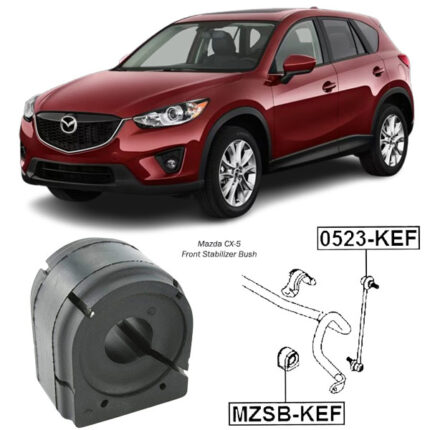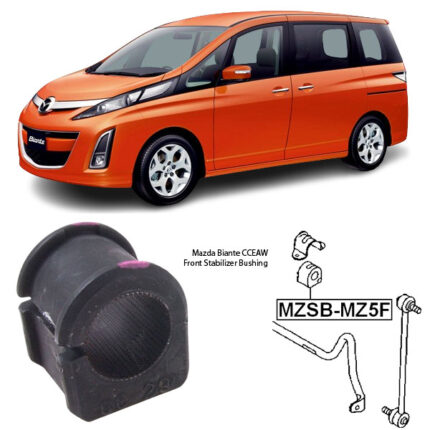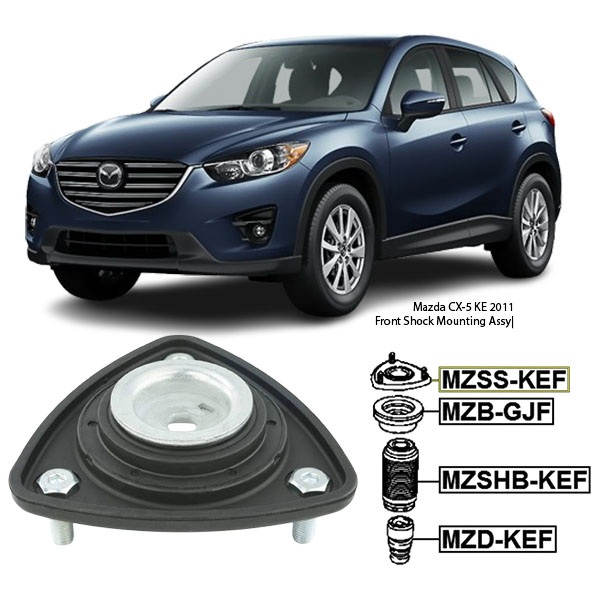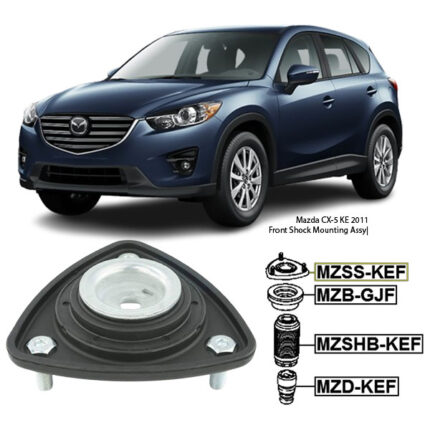Get Mazda CX-5 KE 2011 Front Shock Mounting Assy MZSS-KEF in Kenya
The shock mounting assembly, often referred to as the shock absorber mounting or shock mount, is a crucial component in a vehicle’s suspension system. It serves as the interface between the shock absorber and the vehicle’s chassis or frame, playing a vital role in ensuring proper function and longevity of the shock absorbers. Here’s an in-depth look at the functions, components, and signs of wear or failure of the shock mounting assembly:
Functions of Shock Mounting Assembly
- Secure Attachment
- Primary Function: Provide a secure connection point for the shock absorber.
- Details: The shock mounting assembly ensures that the shock absorber is firmly attached to the vehicle’s chassis, allowing it to effectively absorb and dampen road shocks.
- Vibration Isolation
- Primary Function: Isolate vibrations and noise from the vehicle’s chassis.
- Details: The mounting assembly typically includes rubber or polyurethane bushings that absorb vibrations and noise, preventing them from being transmitted to the vehicle’s cabin.
- Allowing Controlled Movement
- Primary Function: Facilitate the proper movement of the shock absorber.
- Details: The mounting assembly allows the shock absorber to move and pivot as the suspension travels, ensuring smooth operation and effective damping of road impacts.
- Enhancing Ride Comfort
- Primary Function: Improve ride comfort by reducing harshness.
- Details: By absorbing vibrations and shocks, the shock mounting assembly contributes to a smoother and more comfortable ride for the occupants.
- Maintaining Suspension Geometry
- Primary Function: Ensure proper alignment and function of the suspension system.
- Details: The mounting assembly maintains the correct positioning of the shock absorber, which is essential for preserving the suspension geometry and ensuring optimal handling and stability.
Components of Shock Mounting Assembly
- Mounting Plate
- Description: The primary component that attaches to the vehicle’s chassis.
- Function: Provides a stable base for the shock absorber.
- Bushings
- Description: Made of rubber or polyurethane, these components sit between the mounting plate and the shock absorber.
- Function: Absorb vibrations and noise, allowing for smooth and quiet operation.
- Bearings (in some designs)
- Description: Found in strut mounts, these bearings allow for smooth pivoting motion.
- Function: Facilitate the rotational movement of the strut, important for steering in front suspension systems.
- Bolts and Fasteners
- Description: Hardware used to secure the mounting assembly to the vehicle and the shock absorber to the mount.
- Function: Ensure the components are tightly and securely attached.
Signs of Worn or Failing Shock Mounting Assembly
- Excessive Noise
- Description: Clunking, banging, or rattling noises from the suspension, especially when driving over bumps.
- Details: Worn or damaged bushings can cause metal-to-metal contact, leading to noise as the shock absorber moves.
- Poor Handling and Stability
- Description: Noticeable decrease in handling performance, increased body roll, or instability.
- Details: A failing shock mount can affect the alignment and function of the shock absorber, compromising vehicle stability and handling.
- Excessive Vibration
- Description: Increased vibrations felt through the vehicle’s cabin.
- Details: If the bushings or other components in the mount assembly are worn out, they can no longer effectively isolate vibrations, leading to a rougher ride.
- Visible Damage
- Description: Cracks, tears, or deformation in the bushings or mounting plate.
- Details: Regular inspection can reveal physical damage, indicating that the mount assembly needs replacement.
- Uneven Tire Wear
- Description: Abnormal wear patterns on the tires, particularly on the edges.
- Details: Misalignment due to a failing shock mount can cause uneven tire wear, as the suspension components are not functioning correctly.
- Steering Issues (for front shock mounts)
- Description: Steering feels loose, imprecise, or produces noise when turning.
- Details: In vehicles with strut-type front suspensions, worn strut mounts can affect steering performance, as the bearing in the mount allows for smooth pivoting of the strut during steering.
Maintenance and Replacement
- Regular Inspection
- Routine Checks: Include shock mounting assemblies in routine maintenance checks, looking for signs of wear or damage.
- Professional Assessment: Have a mechanic inspect the mounts during regular servicing, especially if you notice any symptoms of failure.
- Timely Replacement
- Replace Worn Components: If any part of the mounting assembly shows signs of wear or damage, replace it promptly to prevent further issues.
- Quality Parts: Use high-quality OEM or reputable aftermarket parts to ensure durability and proper fitment.
- Professional Installation
- Expert Service: Consider having a qualified mechanic perform the replacement, as it may require specialized tools and expertise to remove and install the mounts correctly.
- Alignment Check: After replacing shock mounts, have a professional wheel alignment performed to ensure proper suspension geometry and handling.
Follow us on Facebook for more parts.




